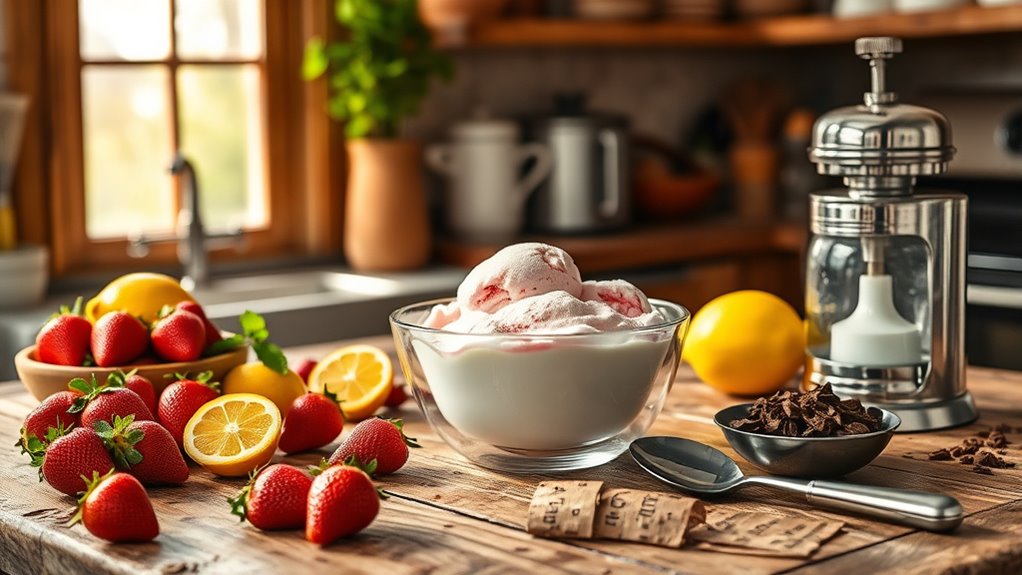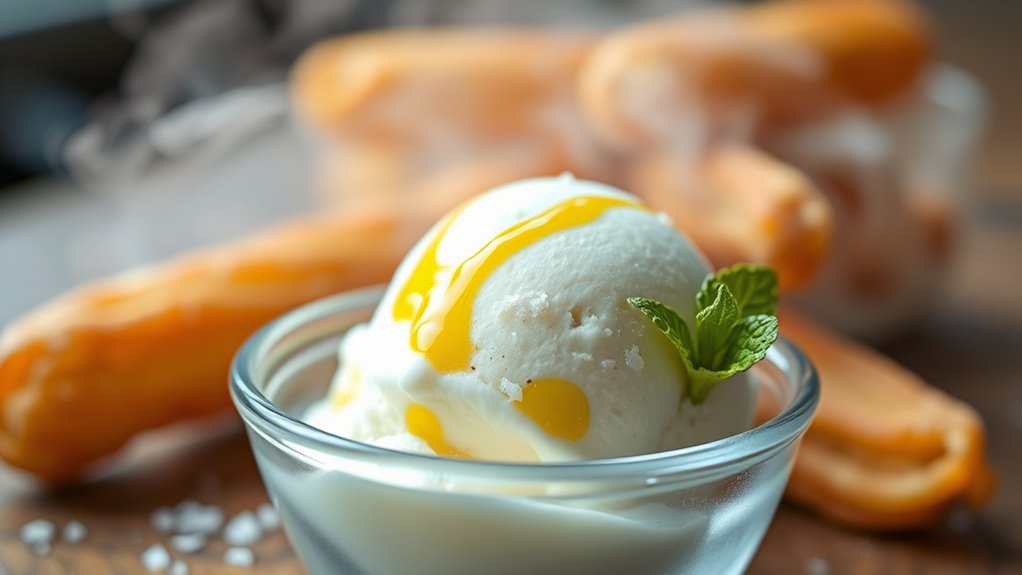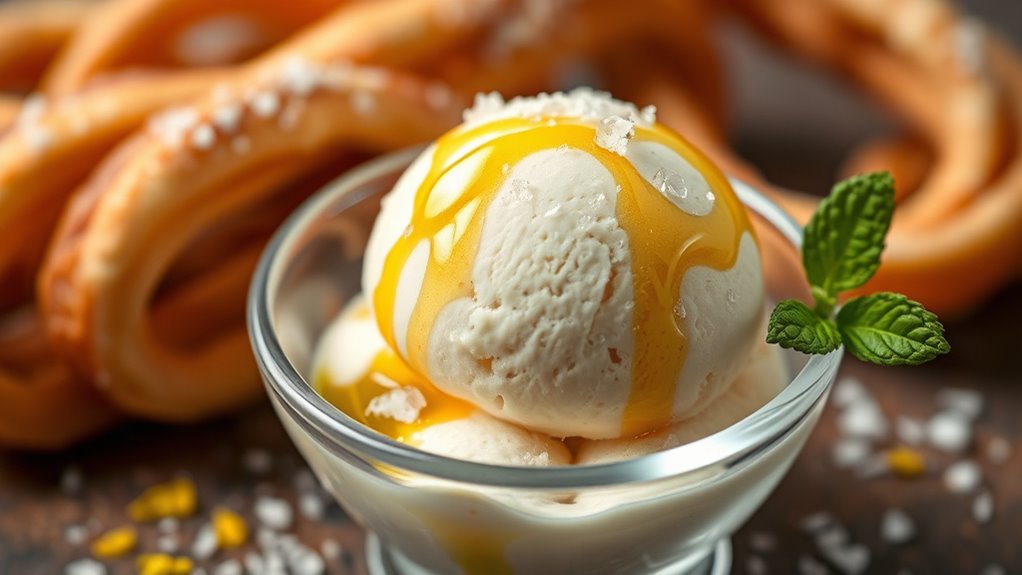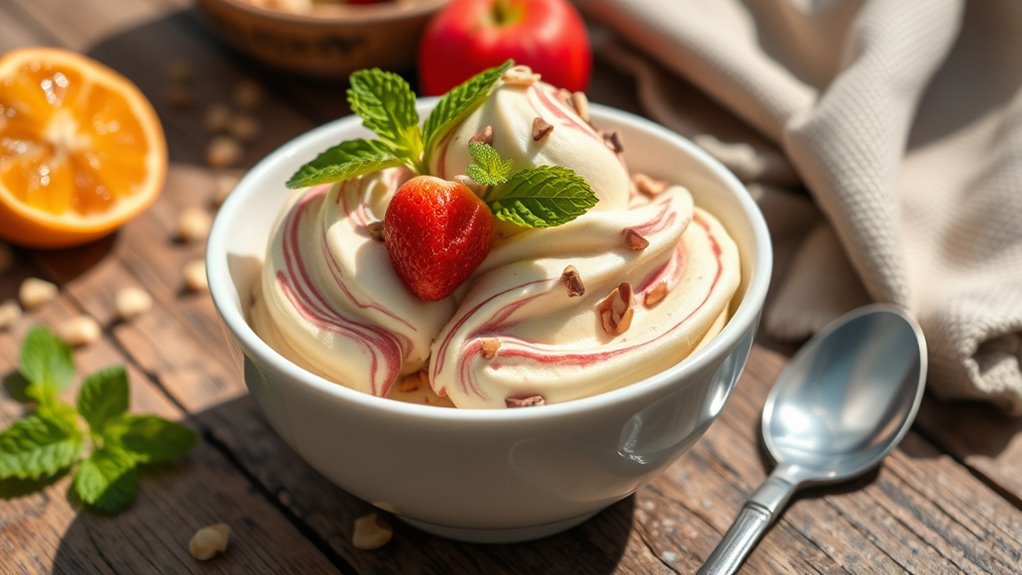This Spanish ice cream is a silky custard, built with milk, cream, and just enough sugar to sweeten without heaviness. You’ll whisk egg yolks with sugar, temper them into a warm milk–cream base, then simmer briefly to bloom vanilla or citrus notes. Chill until well set, then zip in bright flavors or a touch of spice. The result coats your tongue with subtle viscosity and a sunlit finish—perfect for pairing with citrus or a drizzle of olive oil; there’s more to explore beyond this.
Ingredients and Quantity

You’ll need a few simple ingredients to make traditional Spanish ice cream at home: milk, cream, sugar, and egg yolks form the creamy base, while vanilla or lemon zest adds a gentle aroma.
| Ingredient | Quantity | Purpose |
|---|---|---|
| Milk | 2 cups | Creaminess |
| Cream | 1 cup | Rich body |
| Sugar | 3/4 cup | Sweetness |
| Egg yolks | 4 | Emulsion |
| Flavoring | 1 tsp vanilla or zest | Aroma and depth |
You’ll feel the texture as it thickens, bright with citrus or vanilla. If you want ice cream flavors beyond tradition, consider ingredient substitutions like almond milk or coconut cream, keeping balance with eggs. Subtly adjust sugar for sweetness. The point is clarity: know what you swap, why, and how it changes the finish. Freedom lives in choice, not clutter.
Preparations

Before you begin, gather and measure every component: milk, cream, sugar, egg yolks, and your chosen flavoring, so the process moves smoothly and you can monitor texture as it thickens. You’ll whisk yolks and sugar, then temper with warm milk, creating a satin base that clings to a spoon. Simmer briefly to bloom flavors, then chill thoroughly; cold helps fat and air harmonize during churn. As the mixture rests, consider flavor variations to suit your mood—citrus zest, cinnamon, almond, or coffee—without losing balance. When you test for readiness, aim for a silky coat with subtle viscosity. If a component doesn’t suit you, note ingredient substitutions that maintain structure without sacrificing mouthfeel. Precision matters, yet flexibility fuels fearless flavor exploration.
How to Cook

- Bring the milk and cream to a gentle simmer.
- Whisk the tempered yolks into the hot mixture until it forms a pale, glossy ribbon that clings to the spoon.
- Temper the heat carefully; do not rush the process.
- Let the mixture thicken into a smooth custard that coats the back of a spatula.
- Stir steadily and taste as you go.
- Avoid overcooking; a satin texture indicates the custard is done.
- Chill the base fully.
- Integrate your chosen flavor, adjusting sugar if necessary.
- Explore cooking techniques such as slow emulsions, gentle reduction, and precise temperature control.
- When freezing, consider flavor combinations that balance complexity with brightness (e.g., citrus zest, almond, vanilla, or a hint of smoky spice).
- Embrace clarity, precision, and fearless experimentation throughout the process.
How to Serve

Serve Spanish ice cream in small, chilled bowls or cones so the cold, glossy scoop remains pristine. You’ll present the first bite with intention, then let the flavors speak for themselves. Serving suggestions invite curiosity: pair the ice cream with citrus zest, a drizzle of olive oil, or a pinch of flaky salt to heighten contrast. Keep portions modest to preserve texture and melt resistance. Consider temperature contrast—hot churros or warm chocolate sauce can accentuate the chill beneath the surface. Presentation ideas emphasize simplicity and rhythm: a single scoop, a clean plate, a tiny mint leaf or citrus twist for color. You guide the experience with restraint, letting aroma, sheen, and mouthfeel deliver freedom rather than clutter. Enjoy the effortless, seductive clarity of each finish.
Tips

Try a few practical tweaks to keep that Spanish ice cream pristine: chill your mixing bowls and scoopers, keep the base well below freezing until just before serving, and work quickly to minimize softening.
Tips:
- Trust texture over time: small batches stay scoopable, larger ones form a brief, glossy glaze.
- Balance ice cream flavors with citrus notes or saffron to heighten aroma and color.
- Serve with warm toppings that contrast cold, like caramelized almond shards.
- Pair suggestions matter: match flavors to desserts and occasion for precise serving suggestions.
- Store and handle with care to preserve mouthfeel, avoiding icy grain.
- ice cream flavors
- serving suggestions
- texture vs. time
- temperature discipline
- complementary accompaniments
Food Value and Benefit
Spanish ice cream offers more than just a delightful treat; it provides a valuable nutritional profile that supports overall health and well-being. Made primarily with dairy and enhanced with natural flavor boosters like citrus or saffron, this dessert supplies essential nutrients while delivering satisfying taste.
Spanish ice cream blends dairy richness with bright citrus notes for a nourishing, satisfying treat.
Food Value of Spanish Ice Cream:
- Rich in high-quality protein from dairy, aiding muscle repair and maintenance.
- Contains calcium, essential for strong bones and teeth.
- Includes balanced fats that contribute to sustained energy and satiety.
- Provides natural flavor enhancers such as citrus, which contribute vitamin C and antioxidants.
Benefits of Eating Spanish Ice Cream:
- Supports muscle function and promotes bone health due to its calcium and protein content.
- Offers steady energy release without heaviness, making it an excellent choice for a light indulgence.
- Helps curb cravings through a balanced combination of fats and proteins, reducing the tendency for overeating.
- Enhances digestion with citrus components that stimulate digestive enzymes.
- Can be customized with almond milk or yogurt to modify fat profiles for healthier alternatives.
- When topped with fresh fruit, it adds natural sweetness and extra vitamins, increasing nutritional value.
Key Vitamins and Minerals in this Recipe:
- Calcium: vital for bone strength and nerve function.
- Vitamin C: from citrus, supports immune health and antioxidant protection.
- Protein: essential for tissue repair and muscle growth.
- Potassium and magnesium: present in dairy, aid in maintaining electrolyte balance and muscle function.
Frequently Asked Questions
Can I Substitute Dairy With Non-Dairy Milk in This Recipe?
Dairy alternatives are usable, and yes, you can swap in non-dairy options. Interesting stat: 58% of consumers explore plant milks. You’ll notice texture change, but with creamy non dairy options you’ll still get rich flavor and smooth mouthfeel.
What Equipment Is Essential for Authentic Spanish Ice Cream?
You’ll need ice cream makers and sturdy thermometers for authentic Spanish ice cream, and with them you’ll chase authentic flavors, tasting creaminess, saffron, citrus, and almond—precision meets freedom, letting you craft smooth, vibrant, seasonally inspired batches.
How Long Should the Ice Cream Churn Before Freezing?
You should churn for about 20 to 30 minutes, depending on your machine. You’ll notice the mixture thickens, envelopes air, and achieves a smooth Ice cream texture; shorter times yield softer results, longer fosters firmness, almost custard-like depth.
Can I Make This Recipe Gluten-Free?
Yes, you can; you’ll use gluten free alternatives and test gluten content as you go, ensuring clean utensils. Coincidence threads through flavors, guiding you to trust taste. You’ll feel freedom in each thoughtfully churned, gluten-free scoop.
Where Can I Find Traditional Spanish Flavor Ingredients?
You’ll find traditional Spanish flavor ingredients at local markets and specialty stores, where saffron, orange zest, and manchego-inspired notes await; explore aromas, textures, and bright citrus to craft an authentic, liberating ice cream experience.
